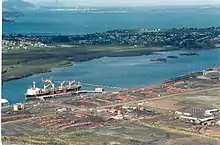Port Whangārei
Port Whangārei is an industrial area of Whangārei, in Northland Region, New Zealand. It is southeast of the city centre, connected by a bridge across Limeburners Creek. It was once called Kioreroa.[3] The southernmost part of the area contains Port Nikau which has industrial buildings and commercial berths.[4]
Port Whangārei | |
|---|---|
| Coordinates: 35.745°S 174.346°E | |
| Country | New Zealand |
| City | Whangārei |
| Local authority | Whangarei District Council |
| Electoral ward | Whangārei Urban Ward |
| Area | |
| • Land | 741 ha (1,831 acres) |
| Population (June 2022)[2] | |
| • Total | 270 |
| Morningside | Riverside | Parahaki |
| Raumanga |
|
Onerahi |
| Oakleigh | (Whangārei Harbour) | Onerahi |
History
One of the early cemeteries for Whangārei was Kioreroa Cemetery, on the western part of what is now Port Whangārei. It was used from 1882 to 1946.[5]
The area was developed from the 1920s as Whangārei's port, and in the mid-1960s it was the ninth-busiest port in New Zealand.[6] It needed more space to handle the increasing size of ships, and Northport was developed at Marsden Point to replace it, with the transition complete in 2007.[7]
There has been a suggestion that the Royal New Zealand Navy might establish a base at Port Whangārei.[8]
Demographics
The statistical area of Port-Limeburners, which includes a slightly larger area than Port Whangārei, covers 7.41 km2 (2.86 sq mi)[1] and had an estimated population of 270 as of June 2022,[2] with a population density of 36.4 people per km2.
| Year | Pop. | ±% p.a. |
|---|---|---|
| 2006 | 51 | — |
| 2013 | 39 | −3.76% |
| 2018 | 102 | +21.20% |
| Source: [9] | ||

Port-Limeburners had a population of 102 at the 2018 New Zealand census, an increase of 63 people (161.5%) since the 2013 census, and an increase of 51 people (100.0%) since the 2006 census. There were 36 households, comprising 69 males and 30 females, giving a sex ratio of 2.3 males per female. The median age was 46.9 years (compared with 37.4 years nationally), with 9 people (8.8%) aged under 15 years, 9 (8.8%) aged 15 to 29, 66 (64.7%) aged 30 to 64, and 18 (17.6%) aged 65 or older.
Ethnicities were 64.7% European/Pākehā, 26.5% Māori, 2.9% Pacific peoples, 14.7% Asian, and 2.9% other ethnicities. People may identify with more than one ethnicity.
The percentage of people born overseas was 35.3, compared with 27.1% nationally.
Although some people chose not to answer the census's question about religious affiliation, 58.8% had no religion, 26.5% were Christian, 8.8% had Māori religious beliefs, 2.9% were Hindu and 2.9% had other religions.
Of those at least 15 years old, 12 (12.9%) people had a bachelor's or higher degree, and 15 (16.1%) people had no formal qualifications. The median income was $22,800, compared with $31,800 nationally. 9 people (9.7%) earned over $70,000 compared to 17.2% nationally. The employment status of those at least 15 was that 51 (54.8%) people were employed full-time, 6 (6.5%) were part-time, and 3 (3.2%) were unemployed.[9]
Notes
- "ArcGIS Web Application". statsnz.maps.arcgis.com. Retrieved 24 April 2022.
- "Population estimate tables - NZ.Stat". Statistics New Zealand. Retrieved 25 October 2022.
- "Official Name: Port Whangārei". New Zealand Gazetteer. Retrieved 16 May 2020.
- "Tai Tokerau Northland Growth Study" (PDF). Ministry for Primary Industries. February 2015. p. 77.
- "Historic Cemeteries". wdc.govt.nz. Whangarei District Council. 15 January 2020. Archived from the original on 24 September 2020. Retrieved 2 February 2021.
- "Whangarei". An Encyclopaedia of New Zealand. 1966.
- "Ports of Whangarei" (PDF). Whangarei District Council. May 2010. p. 3.
- "Whangārei set for 'massive growth' thanks to infrastructure spend-up". Northern Advocate. 1 February 2020.
- "Statistical area 1 dataset for 2018 Census". Statistics New Zealand. March 2020. Port-Limeburners (107900). 2018 Census place summary: Port-Limeburners